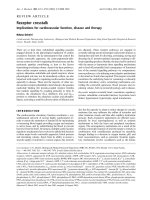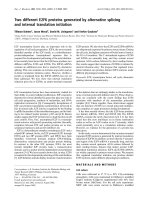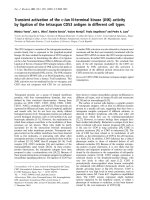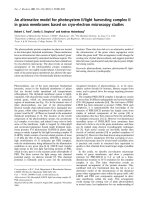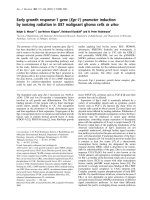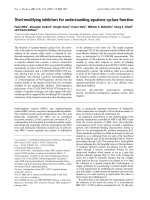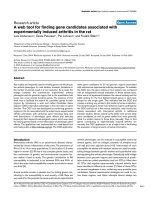Báo cáo y học: "Early Different roles for non-receptor tyrosine kinases in arachidonate release induced by zymosan and Staphylococcus aureus in macrophages" ppsx
Bạn đang xem bản rút gọn của tài liệu. Xem và tải ngay bản đầy đủ của tài liệu tại đây (1.12 MB, 10 trang )
BioMed Central
Page 1 of 10
(page number not for citation purposes)
Journal of Inflammation
Open Access
Research
Different roles for non-receptor tyrosine kinases in arachidonate
release induced by zymosan and Staphylococcus aureus in
macrophages
Sandra Olsson and Roger Sundler*
Address: Department of Experimental Medical Science Lund University, BMC, B12, SE-22184 Lund, Sweden
Email: Sandra Olsson - ; Roger Sundler* -
* Corresponding author
Abstract
Background: Yeast and bacteria elicit arachidonate release in macrophages, leading to the
formation of leukotrienes and prostaglandins, important mediators of inflammation. Receptors
recognising various microbes have been identified, but the signalling pathways are not entirely
understood. Cytosolic phospholipase A
2
is a major down-stream target and this enzyme is
regulated by both phosphorylation and an increase in intracellular Ca
2+
. Potential signal
components are MAP kinases, phosphatidylinositol 3-kinase and phospholipase Cγ2. The latter can
undergo tyrosine phosphorylation, and Src family kinases might carry out this phosphorylation. Btk,
a Tec family kinase, could also be important. Our aim was to further elucidate the role of Src family
kinases and Btk.
Methods: Arachidonate release from murine peritoneal macrophages was measured by prior
radiolabeling. Furthermore, immunoprecipitation and Western blotting were used to monitor
changes in activity/phosphorylation of intermediate signal components. To determine the role of
Src family kinases two different inhibitors with broad specificity (PP2 and the Src kinase inhibitor
1, SKI-1) were used as well as the Btk inhibitor LFM-A13.
Results: Arachidonate release initiated by either Staphylococcus aureus or yeast-derived zymosan
beads was shown to depend on members of the Src kinase family as well as Btk. Src kinases were
found to act upstream of Btk, phosphatidylinositol 3-kinase, phospholipase Cγ2 and the MAP
kinases ERK and p38, thereby affecting all branches of the signalling investigated. In contrast, Btk
was not involved in the activation of the MAP-kinases. Since the cytosolic phospholipase A
2
in
macrophages is regulated by both phosphorylation (via ERK and p38) and an increase in intracellular
Ca
2+
, we propose that members of the Src kinase family are involved in both types of regulation,
while the role of Btk may be restricted to the latter type.
Conclusion: Arachidonate release induced by either Staphylococcus aureus or zymosan was found
to depend on Src family kinases as well as Btk. While members of the Src kinase family were shown
to act upstream of Btk and the MAP kinases, Btk plays another role independent of MAP kinases,
but down-stream of the Src family kinases.
Published: 04 May 2006
Journal of Inflammation 2006, 3:8 doi:10.1186/1476-9255-3-8
Received: 05 October 2005
Accepted: 04 May 2006
This article is available from: />© 2006 Olsson and Sundler; licensee BioMed Central Ltd.
This is an Open Access article distributed under the terms of the Creative Commons Attribution License ( />),
which permits unrestricted use, distribution, and reproduction in any medium, provided the original work is properly cited.
Journal of Inflammation 2006, 3:8 />Page 2 of 10
(page number not for citation purposes)
Background
Leukotrienes and prostaglandins are important mediators
of inflammation, and arachidonate is their precursor. In
resident peritoneal mouse macrophages, cytosolic phos-
pholipase A
2
(cPLA
2
) is the major enzyme responsible for
release of arachidonate and this enzyme is regulated by
both phosphorylation and an increase in intracellular
Ca
2+
[1,2].
Zymosan, a cell wall preparation from Saccharomyces cere-
visiae enriched in mannans and glucans, as well as many
bacterial species, are known to elicit arachidonate release
in macrophages. There are now several Toll-like and other
receptors known that are potentially engaged in initiating
this cellular response, but the signalling pathway is not
understood in its entirety. We have earlier shown that
phosphatidylinositol 3-kinase (PI3K) has an important
role in zymosan- and bacteria-induced signalling leading
to cPLA
2
activation by acting upstream of phospholipase
Cγ2 (PLCγ2) [3], which becomes activated via tyrosine
phosphorylation and/or translocation to the membrane
after stimulation with zymosan.
The products of the PLC reaction result in activation of
protein kinase C, with the subsequent activation of the
MEK/ERK pathway and an increase in cytosolic Ca
2+
,
respectively. Both of these events will lead to activation of
cPLA
2
. The MAP kinases ERK and p38 both contribute to
the activation of cPLA
2
in response to zymosan or the
Gram-negative bacterium Prevotella intermedia [4] and the
downstream kinase MAP kinase signal-integrating kinase-
1 (Mnk-1) has been proposed to play a role in the phos-
phorylation of cPLA
2
[5].
The PLC family includes three subgroups (β, γ and δ) and
PLCγ is known to undergo tyrosine phosphorylation, pos-
sibly as part of its activation. The tyrosine kinase(s)
involved in PLCγ activation are not clearly identified, but
the Src family kinases (SFK) are candidates since PLCγ is a
possible substrate [6]. Members of the SFK are known to
play a critical role in many signaling pathways, with a
putative role in inflammation. Furthermore, SFK have
been shown to interact with both PLCγ [7,8] and PI3K [9-
11]. However, it is not known whether SFK are involved
in responses induced in macrophages by zymosan or bac-
teria. As a key downstream target for SFK, Btk, a member
of the Tec kinase family, may be important in receptor
dependent signalling in a variety of hematopoietic cell lin-
eages [12], but if it plays a role in the eicosanoid response
in macrophages is unknown. The role of Btk has been
underlined by phenotypic analysis of cells with naturally
occurring mutations in Btk, such as those from the xid
mouse [13,14]. These studies show that Btk is important
downstream of the B-cell antigen receptor, where PI3K
and SFK function upstream of Btk [15]. To determine the
role of SFK two different inhibitors with broad specificity
(PP2 and the Src kinase inhibitor 1, SKI-1) were used. This
is of particular importance due to the frequent occurrence
of redundancy among the individual SFK [16,17].
Our results indicate that SFK and Btk play differential
roles in arachidonate release induced by Staphylococcus
aureus (S. aureus) and yeast-derived zymosan beads and
that SFK act upstream of PI3K, PLCγ2 and MAP kinases,
whereas Btk plays a separate role independent of MAP
kinases, but down-stream of the SFK.
Methods
Materials
Zymosan, SU6656 and wortmannin, were from Sigma
Chemical Co. (St Louis, MO, USA). Heat-killed S. aureus
was kindly provided by Dr Lars Björck, BMC, Lund Uni-
versity. PP2 was from Biomol (Plymouth Meeting, PA,
USA), while SP600125 was from Tocris Cockson (North-
point, UK). LFM-A13 and Src kinase inhibitor I (SKI-1)
from Calbiochem (La Jolla, CA, USA). [
3
H]Arachidonic
acid (196 Ci/mmol) was from Amersham international
(Little Chalfont, UK). Antibodies against p-JNK, PLC-γ2,
ERK-2 and phosphotyrosine as well as HRP conjugated
secondary antibodies, were from Santa Cruz Biotechnol-
ogy (Santa Cruz, CA, USA). Antibodies against p-ERK, p-
p38 and pAkt (Thr308) were from New England Biolabs
(Beverly, MA, USA). Antibodies against pAkt (Ser473) and
pBtk (Tyr223) were from Cell Signaling Technology (Bev-
erly, MA, USA). The Mnk-1 inhibitor CGP057380 was a
kind gift from Dr Hermann Gram, Novartis Pharma AG,
Basel, Switzerland. Zymosan and bacteria were dispersed
in PBS. Zymosan was used at 0,2 mg/ml and bacteria at a
concentration of 2,5*10^7/ml. The inhibitors LFM-A13,
PP2, CGP057380, SU6656, SKI-1 and wortmannin were
dissolved in dimethyl sulphoxide (DMSO) and added to
cells resulting in a final concentration of DMSO of less
than 0.3%.
Isolation and culture of macrophages
Peritoneal macrophages were isolated from female out-
bred NMRI mice by adherence in a humidified atmos-
phere of 5% CO
2
in air at 37°C. Non-adherent cells were
removed after 2 h and the rest of the cells were incubated
in medium 199 supplemented with 1% fetal bovine
serum for 18–20 h. During this incubation cells were
labelled with [
3
H]arachidonic acid in some experiments.
Release of [
3
H]arachidonate
Cells labelled with 0,5 µCi [
3
H]arachidonic acid/well for
18–20 h, were washed three times with PBS, and stimu-
lated in serum-free medium. At the end of the experiment
the medium was collected and the cells scraped off the
dishes in 0,1% Triton X-100 in water. The collected
medium was centrifuged and the arachidonate released
Journal of Inflammation 2006, 3:8 />Page 3 of 10
(page number not for citation purposes)
from cellular phospholipids was determined by liquid
scintillation counting. The release into the collected
medium is expressed as a percentage of total recovered
radioactivity in cells and medium.
Immunoblotting
Cells were cultured in 10 cm
2
dishes and stimulated in a
serum-free medium. When inhibitors were used, they
were added 15 min. before stimulus. After stimulation the
cells were scraped off the dishes in 110 µl sample buffer
and equal amounts of cell lysate were subjected to SDS-
PAGE. The proteins were transferred to polyvinylidene
fluoride (PVDF) membranes which were blocked in 3% or
5% non-fat milk/gelatin for 1 h followed by incubation
with different antibodies. Bound antibodies were detected
with secondary horseradish peroxidase-labeled antibod-
ies and enhanced chemiluminescence using LAS 1000
Plus (Fuji Film, Stockholm, Sweden). To assure equal
loading of the gels the membranes were stripped and rep-
robed with ERK-2 antibody, or as indicated.
Immunoprecipitation
Macrophages (approx. 10
6
cells) were stimulated in
serum-free medium. When inhibitors were used, they
were added 15 min. before the stimulus. At the end of the
experiment cells were washed with ice-cold PBS and
scraped off the dish in lysis buffer (0.1 M TrisCl pH 7.4,
150 mM NaCl, 1 mM EDTA, 1 % nonionic detergent (Ige-
pal, polyoxyethylene nonylphenol), 20 mM NaF, 1 mM
Na
3
Vo4, 1 mM PMSF and 1 µg/ml each of pepstatin and
leupeptin). After centrifugation (10
4
× g) for 10 min at
4°C the supernatant was incubated with an antibody
against PLC-γ2. The immune complexes were captured
using protein A-Sepharose (50% w/v). The samples were
centrifuged and the immune complexes were washed
three times in lysis buffer. The immunoprecipitated pro-
teins were dissolved in 2X sample buffer and subjected to
SDS-PAGE (7% acrylamide) and analyzed by Western
blotting.
Results
Src family kinases transmit signal(s) to arachidonate
release by acting upstream of MAP kinases
Both zymosan and Gram-negative bacteria induce ara-
chidonate release in mouse macrophages [4], zymosan
being the more potent of the two classes of stimuli. SFK
are important in many signalling pathways, but their role
in the present process is so far unknown. To investigate
this two different Src kinase inhibitors (PP2 and SKI-1)
were used. Both SFK inhibitors reduced the response
induced by zymosan and Gram-positive S. aureus in a con-
centration dependent manner (Fig. 1). The decrease at 5
Inhibition by PP2 or SKI-1 of zymosan- and S. aureus-induced release of arachidonateFigure 1
Inhibition by PP2 or SKI-1 of zymosan- and S.aureus-induced release of arachidonate. Macrophages were labeled
with [3H]arachidonic acid for 20 h. The cells were pretreated for 15 min with the indicated concentrations of PP2 (A) or SKI-
1 (B) followed by stimulation with either zymosan (●) for 45 min or S.aureus (▲) for 60 min. Results are mean ± SEM (n = 3)
and corrected for the release in control cultures.
Journal of Inflammation 2006, 3:8 />Page 4 of 10
(page number not for citation purposes)
µM PP2 was approximately 59% for zymosan and 84%
for S. aureus. SKI-1 (5 µM) inhibited the zymosan-induced
release by approximately 82% and the S. aureus-induced
release by 83%.
The MAP kinases ERK and p38 are both known to contrib-
ute to the activation of cPLA
2
in response to zymosan or
bacteria [4]. Both zymosan and whole bacteria induce reg-
ulatory phosphorylations of these MAP kinases and we
show here that pretreatment of the cells with PP2 (1–10
µM) decreased these phosphorylations in the case of not
only ERK and p38, but also of JNK (Fig. 2A, B). Also SKI-
1 was able to decrease the zymosan- and bacteria-induced
phosphorylation of ERK (Fig. 2C).
To establish whether also JNK might play a role in the acti-
vation of cPLA
2
SP600125, a JNK inhibitor [18] was tried.
Pretreatment with SP600125 (5–40 µM) led to a concen-
tration dependent decrease of the zymosan-induced ara-
chidonate release. However, this was accompanied by a
parallel inhibition of the phosphorylation of the MAP
kinases ERK, p38 and JNK as detected by antibodies
against the phosphorylated MAP kinases (not shown).
Thus, under our conditions SP600125 may also act as an
inhibitor upstream of several MAP kinases.
It has been suggested that the kinase Mnk-1, downstream
of both ERK and p38, might transmit the signal to some
of the phosphorylations necessary for the activation of
cPLA
2
[5]. Treatment of cells with the Mnk inhibitor CGP
Inhibition by PP2 or SKI-1 of zymosan- and S. aureus- induced phosphorylation of MAP kinasesFigure 2
Inhibition by PP2 or SKI-1 of zymosan- and S.aureus- induced phosphorylation of MAP kinases. Macrophages were
pretreated for 15 min with PP2 (1–10 µM), followed by stimulation with zymosan (A) or S.aureus (B) for 20 min. (C) Macro-
phages were pretreated for 15 min with SKI-1 (5 µM), followed by stimulation with zymosan or S.aureus for 20 min. Equal
amounts of cell lysate were run on 10% polyacrylamide gels and probed with phosphospecific antibodies against ERK, p38 and
JNK. The membrane was reprobed with ERK-2 antibody to verify equal loading of protein.
Table 1: Effects of the Mnk-1 inhibitor CGP057380 on
arachidonate release induced by zymosan. Macrophages were
labelled with [3H]arachidonic acid for 20 h. The cells were
pretreated for 15 min with the indicated concentrations of
CGP507380 followed by stimulation with zymosan for 45 min.
The release of radiolabel is expressed as percentage of total
cellular
3
H. The results are expressed as mean ± S.E.M. (n = 3).
[
3
H]Arachidonate release (% of total
3
H)
(n = 3)
-20 µM40 µM
12.9 ± 0.9 7.6 ± 0.9 6.5 ± 1.4
Journal of Inflammation 2006, 3:8 />Page 5 of 10
(page number not for citation purposes)
57380 (20 and 40µM) resulted in partial inhibition (41
and 50%, respectively) of the arachidonate release in
response to zymosan (Table 1).
Zymosan-induced phosphorylation of Akt and PLC
γ
2
depend on Src kinases
We have previously shown that PI3K has an important
role in the zymosan and bacteria induced signalling to
cPLA
2
activation and arachidonate release [19]. PI3K can
cause activation of the serine/threonine protein kinase
Akt. The activation is dependent on phosphorylation of
two sites, one in the activation loop of the kinase core (Thr
308) and one near the carboxy terminus (Ser 473).
Zymosan beads, in contrast to S. aureus, induced Akt
phosphorylation at both Ser 473 and Thr 308 in macro-
phages, as detected by phosphospecific Akt antibodies
(Fig. 3A). The phosphorylation of both sites appeared to
depend on SFK activation and PI3K. This can be seen as
decreases in these phosphorylations after inhibition with
either PP2 or wortmannin (Fig. 3B).
PLCγ2 is considered to be activated by tyrosine phospho-
rylation and/or by the product of PI3K, but both PI3K-
dependent and -independent pathways leading to activa-
tion have been demonstrated. The role of Src kinases in
zymosan-induced PLCγ2 activation was investigated by
immunoprecipitation with a PLCγ2 specific antibody. A
prominent tyrosine phosphorylation was induced by
zymosan, but was not detected in cells exposed to S.
aureus (Fig. 4A). Pretreatment of the cells with PP2 (Fig.
4B) or SKI-1 (Fig. 4C) clearly inhibited the zymosan-
induced tyrosine phosphorylation of PLCγ2. In agreement
with previous findings [3], inhibition of PI3K with wort-
mannin did not cause such inhibition (Fig. 4B).
MAP kinase-independent role of Btk down-stream of Src
kinases
Btk is a member of the Tec family of cytoplasmic tyrosine
kinases. Most studies on Btk have been conducted with B-
lymphocytes, where cell activation leads to membrane
translocation of Btk and phosphorylation of two sites (Tyr
551 and Tyr 223). Tyr 551 is situated in the activation
loop and its phosphorylation may be initiated by SFK,
leading to autophosphorylation of Tyr 223, which
appears necessary for full activation [20,21]. Detection of
Btk activation by phosphospecific (Tyr 223) antibody
showed that a low level of phosphorylation on Tyr 223
was present in control cells (Fig. 5A). Furthermore,
zymosan and S. aureus but not LPS or peptidoglycan
induced phosphorylation of Btk in macrophages leading
to enhanced immunostaining of the band detectable in
control cells as well as appearance of an additional band,
Effect of inhibitors against PI3K, Src family kinases and Btk on the tyrosine phosphorylation of AktFigure 3
Effect of inhibitors against PI3K, Src family kinases and Btk on the tyrosine phosphorylation of Akt. Zymosan but
not S. aureus induce tyrosine phosphorylation of Akt. This phosphorylation was affected by inhibitors against PI3K and Src fam-
ily kinases. (A and C) Macrophages were stimulated for 30 min with either zymosan or heat killed S.aureus. (B) Macrophages
were pretreated for 15 min with either PP2 (5 µM) or wortmannin (W, 100 nM), followed by stimulation with zymosan for 30
min. Cell lysates were processed for immunoblotting with the indicated antibody as described in Methods. The membrane was
reprobed with ERK-2 antibody to verify equal loading of proteins. The data are representative of three separate experiments.
Journal of Inflammation 2006, 3:8 />Page 6 of 10
(page number not for citation purposes)
presumably due to additional phosphorylation(s) causing
gel-shift (Fig. 5A). Pretreatment with the PI3K inhibitor
wortmannin or the SFK inhibitors PP2 and SKI-1 caused
total, or pronounced, inhibition of zymosan-induced
phosphorylation of Btk (Fig. 5B). A Src kinase inhibitor
with a different specificity (SU6656;[22]) was much less
inhibitory (Fig. 5B). A different inhibitor profile was
observed when S. aureus was used as stimulus (Fig. 5C).
Btk phosphorylation (on Tyr223) was then insensitive to
wortmannin, but sensitive to all three SFK inhibitors,
including SU6656. These results, together with differences
in the phosphorylation of Akt (Fig. 3A) and PLCγ2 (Fig.
4A) argue for differential engagement of individual SFK
members as well as of PI3K in the response to zymosan
and S. aureus.
Zymosan but not S.aureus induced tyrosine phosphorylation of PLC γ2Figure 4
Zymosan but not S.aureus induced tyrosine phospho-
rylation of PLC γ2. (A) Macrophages were stimulated with
zymosan(z) or S.aureus (S.a) for 45 min. (B and C) Macro-
phages were pretreated for 15 min with either PP2 (5 µM),
wortmannin (W, 100 nM) (B) or SKI-1 (5 µM) (C) followed
by stimulation with zymosan for 30 min. Cell lysates were
immunoprecipitated with antibody against PLCγ2 as
described, followed by Western blot analysis with phospho-
tyrosine-specific antibody. The membrane was stripped and
reprobed with antibody against PLCγ2. The data are repre-
sentative of three separate experiments.
Zymosan and bacteria but not LPS or peptidoglycan (PGN) induce phosphorylation of BtkFigure 5
Zymosan and bacteria but not LPS or peptidoglycan
(PGN) induce phosphorylation of Btk. (A) Macrophages
were stimulated with zymosan (zym), S.aureus (S.a.), LPS or
PGN for 30 min. (B and C) Macrophages were pretreated
for 15 min with either wortmannin (W, 100 nM), PP2 (5 µM),
SU6656 (5 µM) or SKI-1 (5 µM), followed by stimulation with
zymosan (B) or S.aureus (C) for 30 min. Equal amounts of
cell lysate were run on polyacrylamide gels and probed with
phosphospecific antibodies against Btk. The membrane was
reprobed with ERK-2 antibody to verify equal loading of pro-
teins. The data are representative of three separate experi-
ments.
Journal of Inflammation 2006, 3:8 />Page 7 of 10
(page number not for citation purposes)
Interestingly, an inhibitor of Btk (LFM-A13) caused a
decrease in the release of arachidonate induced by both
zymosan and S. aureus (Fig. 6A). The decrease was prom-
inent at 10 µM LFM-A13 with little further change at
higher concentrations (approx. 65% inhibition for
zymosan and ≥ 80% for S .aureus at 50 µM LFM-A13).
However, in contrast to the effect of SFK inhibitors
described above, the inhibition of Btk did not affect the
zymosan- and bacteria-induced phosphorylation of ERK
and p38 (Fig. 6C), neither did it affect the zymosan-
induced phosphorylation of PLCγ2 (Fig. 6B). A partial
inhibition of the phosphorylation of Akt induced by
zymosan was observed (Fig. 6D), but only at higher con-
centrations than required for inhibition of arachidonate
release (Fig. 6A).
These data indicate that Btk has a regulatory role for ara-
chidonate release, is acting downstream of inhibitor-sen-
sitive SFK, but not involved in signalling to MAP kinase
activation.
Discussion
In this report we provide evidence that signalling to
release of arachidonate induced in resident mouse perito-
neal macrophages by non-opsonized zymosan (yeast cell-
wall particles) and the Gram-positive bacterium S. aureus,
is differentially dependent on SFK and the Tec kinase Btk.
Src kinases act upstream of both Btk and the MAP kinases
ERK and p38, thereby also of activating phosphoryla-
tion(s) of cPLA
2
. They are also most likely responsible for
the tyrosine phosphorylation of PLCγ2 that occurs in
Effects of Btk inhibitor on arachidonate release and the phosphorylation of PLCγ2, Akt and MAP kinasesFigure 6
Effects of Btk inhibitor on arachidonate release and the phosphorylation of PLCγ2, Akt and MAP kinases. (A)
Macrophages were labeled with [3H]arachidonic acid for 20 h. The cells were pretreated for 15 min with the indicated concen-
trations of LFM-A13 followed by stimulation with either zymosan (●) for 45 min or S.aureus (▲) for 60 min. Results are mean
± SEM (n = 3) and corrected for the release in control cultures. (B) Macrophages were pretreated for 15 min with LFM-A13
(25 µM), followed by stimulation with zymosan for 30 min. Cell lysates were immunoprecipitated with antibody against PLCγ2
followed by Western blot analysis with phosphotyrosine-specific antibody. The membrane was stripped and reprobed with
antibody against PLCγ2. (C) Macrophages were pretreated for 15 min with LFM-A13 (25 µM), followed by stimulation with
zymosan or S.aureus for 20 min. Equal amounts of cell lysate were run on 10% polyacrylamide gels and probed with phosphos-
pecific antibodies against ERK and p38. The membrane was reprobed with ERK-2 antibody to verify equal loading of protein.
(D) Macrophages were pretreated for 15 min with LFM- A13 (25 µM) followed by stimulation with zymosan for 30 min. West-
ern blot analysis was performed with phosphospecific antibodies against Akt. The membrane was reprobed with ERK-2 anti-
body to verify equal loading of protein. Data shown in B-D are representative of three separate experiments.
Journal of Inflammation 2006, 3:8 />Page 8 of 10
(page number not for citation purposes)
response to zymosan, as shown here and previously [3].
Btk is important for arachidonate release, but independ-
ent of the MAP kinase cascade.
The major enzyme responsible for release of arachidonate
in the cells used in the present study is cPLA
2
, which is reg-
ulated by both phosphorylation(s) and an increase in
intracellular Ca
2+
[1,2]. Several sites on cPLA
2
, especially
in the C-terminal cluster of serine residues [2], become
phosphorylated upon agonist stimulation and the protein
kinase Mnk-1 has been suggested to be involved in the
phosphorylation of one of these (Ser 727) [5]. Our find-
ing that a direct inhibitor of this kinase reduced zymosan-
induced arachidonate release is consistent with the sug-
gestion. Mnk-1 is coordinately regulated by the MAP
kinases ERK and p38 and inhibition of both of these MAP
kinases severely inhibits zymosan-induced arachidonate
release [4]. However, separate inhibition of either of the
two kinases argues for a more prominent role for ERK
than p38 [4]. The SFK inhibitor PP2 counteracted bacte-
ria- and zymosan-induced phosphorylation of both ERK
and p38. PP2 has been shown to inhibit human p38 with
similar potency as the SFK member Lck [23] which could,
potentially, influence the interpretation of our data on
arachidonate release. However, the pronounced inhibi-
tion by PP2 of the activation of MAP kinases, including
p38, makes any direct inhibitory effect on p38 subordi-
nate. A similar inhibitory effect on MAP kinase phospho-
rylation/activation was exerted by SKI-1, as illustrated by
its effect on ERK. SFK are previously known to regulate
MAP kinase activation (see [6] for review). In contrast,
inhibition of Btk did not inhibit the MAP kinase cascade.
PI3K has an important role in zymosan- and bacteria-
induced signalling in macrophages [19]. SFK apparently
affect the zymosan-induced phosphorylation of Akt, a
downstream kinase of PI3K, indicating that one or more
of these tyrosine kinases are situated upstream of PI3K.
SFK and PI3K may interact in several ways; it is known
that the p85 subunit of PI3K is able to interact with both
the SH3 and SH2 domain of Src[9] and it is known that
the p85 subunit can function as a substrate for SFK [6].
Summary of the role of Src kinases and BtkFigure 7
Summary of the role of Src kinases and Btk. Schematic illustration of signaling pathways involved in the activation of
cPLA
2
and arachidonate release in resident mouse macrophages responding to zymosan or S.aureus and the role of Src family
kinases (SFK) and Btk. Broken arrows delineate proposed connections, based on previous or present evidence, that remain to
be confirmed.
Journal of Inflammation 2006, 3:8 />Page 9 of 10
(page number not for citation purposes)
Furthermore, the p85 subunit of PI3K is known to interact
with phosphotyrosine residues on different adaptor pro-
teins. Binding of PI3K to such residues or a tyrosine kinase
at the membrane is likely to help position the catalytic
subunit of PI3K to its lipid substrate.
We now demonstrate that the tyrosine phosphorylation
of PLCγ2 induced by zymosan is dependent on SFK, as
shown by its sensitivity to the inhibitors PP2 and SKI-1.
PLCγ is a possible substrate for Src [6] and the activation
of PLCγ was blocked by PP1 (another Src kinase inhibitor)
both in muscle cells from chicken embryos [7] and in
FDC-P1 cells stimulated by EPO [24]. Furthermore, Src
activation has been shown to induce calcium release via a
PLCγ dependent mechanism in Xenopus egg extracts [8].
These results all indicate that SFK are important regulators
of PLCγ. Because the phosphorylation of PLCγ2 is insensi-
tive to wortmannin, as shown here as well as previously
[3], the effect of PP2 is probably not mediated through
PI3K but either direct or mediated by another kinase. It
should be emphasized, though, that the role of tyrosine
phosphorylation of PLCγ2 in the regulation of its activity
remains unclear (see [25] for review). S.aureus did not
induce detectable tyrosine phosphorylation of PLCγ2.
Nevertheless both phosphorylation of ERK and arachido-
nate release induced by this bacterium were sensitive to
wortmannin (data not shown) and therefore most likely
mediated via PI3K and accompanied by activation of
PLCγ2.
We also found that inhibition of Btk did not affect the
zymosan-induced tyrosine phosphorylation of PLCγ2 in
macrophages. Most studies on Btk have been carried out
in B cells, while information about the role of Btk in mac-
rophage signaling is scarce. Btk activation in B-cells is
known to affect both PI3K and Ca
2+
levels and Btk activa-
tion results in a rise in the level of IP
3
and depletion of
intracellular calcium stores [26]. Furthermore, Btk regu-
lates PtdIns4,5P
2
synthesis which may affect both Ca
2+
-
signaling and PI3K activity [27]. Btk can associate with
PtdIns4P-5kinases, enzymes that synthesize PtdIns4,5P
2
,
and upon activation generate local PtdIns4,5P
2
synthesis
[27]. PtdIns4,5P
2
is a substrate not only for PI3K but also
for PLCγ2 and increased synthesis may well be necessary
to provide substrate for PLCγ2 and also be of importance
for optimal generation of PtdIns3,4,5P
3
[27]. A difference
between the phosphorylation of PLCγ2 by zymosan in
macrophages and its phosphorylation after B cell receptor
cross-linking is the PI3K dependency. Zymosan-induced
PLCγ2 phosphorylation is not inhibited by wortmannin
[3], whereas PLCγ2 phosphorylation in B cells is PI3K
dependent [26,28]. In view of our own data and the find-
ings referred to above, we propose that Btk may primarily
affect arachidonate release via the generation or further
metabolism of PtdIns4,5P
2
and the cellular Ca
2+
-homeos-
tasis.
Conclusion
Arachidonate release initiated in mouse macrophages by
either S. aureus or yeast-derived zymosan beads was found
to depend on SFK members, in part with agonist-specific
differences, as well as the Tec kinase Btk. While Src kinases
were shown to act upstream of Btk, PI3K, PLCγ2 and the
MAP kinases ERK and p38, Btk was not involved in the
activation of ERK and p38. An attempt to summarise the
findings is provided (Fig. 7).
Competing interests
The author(s) declare that they have no competing inter-
ests.
Authors' contributions
SO participated in the design and execution of all experi-
ments and helped to draft the manuscript. RS participated
in the design of the study and in the preparation of the
manuscript. Both authors read and approved the final
manuscript.
Acknowledgements
This work was supported by grants from the Royal Physiographic Society
of Sweden, the Alfred Österlund foundation and the Greta and Johan Kock
foundations. The skilful technical assistance by Pia Lundquist is gratefully
acknowledged.
References
1. Leslie CC: Properties and regulation of cytosolic phospholi-
pase A2. J Biol Chem 1997, 272:16709-16712.
2. Wijkander J, Gewert K, Svensson U, Holst E, Sundler R: Multiple C-
terminal serine phosphorylation accompanies both protein
kinase C-dependent and -independent activation of cytosolic
85 kDa phospholipase A2 in macrophages. Biochem J 1997,
325(Pt 2):405-410.
3. Hiller G, Sundler R: Regulation of phospholipase C-gamma 2
via phosphatidylinositol 3-kinase in macrophages. Cell Signal
2002, 14:169-173.
4. Hiller G, Sundler R: Activation of arachidonate release and
cytosolic phospholipase A2 via extracellular signal-regulated
kinase and p38 mitogen-activated protein kinase in macro-
phages stimulated by bacteria or zymosan. Cell Signal 1999,
11:863-869.
5. Hefner Y, Borsch-Haubold AG, Murakami M, Wilde JI, Pasquet S,
Schieltz D, Ghomashchi F, Yates JR 3rd, Armstrong CG, Paterson A,
et al.: Serine 727 phosphorylation and activation of cytosolic
phospholipase A2 by MNK1-related protein kinases. J Biol
Chem 2000, 275:37542-37551.
6. Thomas SM, Brugge JS: Cellular functions regulated by Src fam-
ily kinases. Annu Rev Cell Dev Biol 1997, 13:513-609.
7. Buitrago C, Gonzalez Pardo V, de Boland AR: Nongenomic action
of 1 alpha,25(OH)(2)-vitamin D3. Activation of muscle cell
PLC gamma through the tyrosine kinase c-Src and PtdIns 3-
kinase. Eur J Biochem 2002, 269:2506-2515.
8. Tokmakov AA, Sato KI, Iwasaki T, Fukami Y: Src kinase induces
calcium release in Xenopus egg extracts via PLCgamma and
IP3-dependent mechanism. Cell Calcium 2002, 32:11-20.
9. Fukui Y, Hanafusa H: Requirement of phosphatidylinositol-3
kinase modification for its association with p60src. Mol Cell
Biol 1991, 11:1972-1979.
Publish with Bio Med Central and every
scientist can read your work free of charge
"BioMed Central will be the most significant development for
disseminating the results of biomedical research in our lifetime."
Sir Paul Nurse, Cancer Research UK
Your research papers will be:
available free of charge to the entire biomedical community
peer reviewed and published immediately upon acceptance
cited in PubMed and archived on PubMed Central
yours — you keep the copyright
Submit your manuscript here:
/>BioMedcentral
Journal of Inflammation 2006, 3:8 />Page 10 of 10
(page number not for citation purposes)
10. Gentili C, Morelli S, Russo De Boland A: Involvement of PI3-
kinase and its association with c-Src in PTH-stimulated rat
enterocytes. J Cell Biochem 2002, 86:773-783.
11. Yu W, Cassara J, Weller PF: Phosphatidylinositide 3-kinase
localizes to cytoplasmic lipid bodies in human polymorpho-
nuclear leukocytes and other myeloid-derived cells. Blood
2000, 95:1078-1085.
12. Kawakami Y, Kitaura J, Hata D, Yao L, Kawakami T: Functions of
Bruton's tyrosine kinase in mast and B cells. J Leukoc Biol 1999,
65:286-290.
13. Rawlings DJ, Saffran DC, Tsukada S, Largaespada DA, Grimaldi JC,
Cohen L, Mohr RN, Bazan JF, Howard M, Copeland NG, et al.: Muta-
tion of unique region of Bruton's tyrosine kinase in immuno-
deficient XID mice. Science 1993, 261:358-361.
14. Tsukada S, Rawlings DJ, Witte ON: Role of Bruton's tyrosine
kinase in immunodeficiency. Curr Opin Immunol 1994, 6:623-630.
15. Li Z, Wahl MI, Eguinoa A, Stephens LR, Hawkins PT, Witte ON:
Phosphatidylinositol 3-kinase-gamma activates Bruton's
tyrosine kinase in concert with Src family kinases. Proc Natl
Acad Sci U S A 1997, 94:13820-13825.
16. Majeed M, Caveggion E, Lowell CA, Berton G: Role of Src kinases
and Syk in Fcgamma receptor-mediated phagocytosis and
phagosome-lysosome fusion. J Leukoc Biol 2001, 70:801-811.
17. Caveggion E, Continolo S, Pixley FJ, Stanley ER, Bowtell DD, Lowell
CA, Berton G: Expression and tyrosine phosphorylation of Cbl
regulates macrophage chemokinetic and chemotactic
movement. J Cell Physiol 2003, 195:276-289.
18. Bennett BL, Sasaki DT, Murray BW, O'Leary EC, Sakata ST, Xu W,
Leisten JC, Motiwala A, Pierce S, Satoh Y, et al.: SP60 an anthrapy-
razolone inhibitor of Jun N-terminal kinase. Proc Natl Acad Sci
U S A 0125, 98:13681-13686.
19. Hiller G, Sternby M, Sundler R, Wijkander J: Phosphatidylinositol
3-kinase in zymosan- and bacteria-induced signalling to
mobilisation of arachidonic acid in macrophages. Biochim Bio-
phys Acta 2000, 1485:163-172.
20. Rawlings DJ, Scharenberg AM, Park H, Wahl MI, Lin S, Kato RM,
Fluckiger AC, Witte ON, Kinet JP: Activation of BTK by a phos-
phorylation mechanism initiated by SRC family kinases. Sci-
ence 1996, 271:822-825.
21. Park H, Wahl MI, Afar DE, Turck CW, Rawlings DJ, Tam C, Scharen-
berg AM, Kinet JP, Witte ON: Regulation of Btk function by a
major autophosphorylation site within the SH3 domain.
Immunity 1996, 4:515-525.
22. Blake RA, Broome MA, Liu X, Wu J, Gishizky M, Sun L, Courtneidge
SA: SU a selective src family kinase inhibitor, used to probe
growth factor signaling. Mol Cell Biol 6656, 20:9018-9027.
23. Bain J, McLauchlan H, Elliott M, Cohen P: The specificities of pro-
tein kinase inhibitors: an update. Biochem J 2003, 371:199-204.
24. Boudot C, Dasse E, Lambert E, Kadri Z, Mayeux P, Chretien S, Haye
B, Billat C, Petitfrere E: Involvement of the Src kinase Lyn in
phospholipase C-gamma 2 phosphorylation and phosphati-
dylinositol 3-kinase activation in Epo signalling. Biochem Bio-
phys Res Commun 2003, 300:437-442.
25. Wilde JI, Watson SP: Regulation of phospholipase C gamma
isoforms in haematopoietic cells: why one, not the other?
Cell Signal 2001, 13:691-701.
26. Fluckiger AC, Li Z, Kato RM, Wahl MI, Ochs HD, Longnecker R,
Kinet JP, Witte ON, Scharenberg AM, Rawlings DJ: Btk/Tec kinases
regulate sustained increases in intracellular Ca2+ following
B-cell receptor activation. Embo J 1998, 17:1973-1985.
27. Saito K, Tolias KF, Saci A, Koon HB, Humphries LA, Scharenberg A,
Rawlings DJ, Kinet JP, Carpenter CL: BTK regulates PtdIns-4,5-P2
synthesis: importance for calcium signaling and PI3K activ-
ity. Immunity 2003, 19:669-678.
28. Takata M, Kurosaki T: A role for Bruton's tyrosine kinase in B
cell antigen receptor-mediated activation of phospholipase
C-gamma 2. J Exp Med 1996, 184:31-40.

